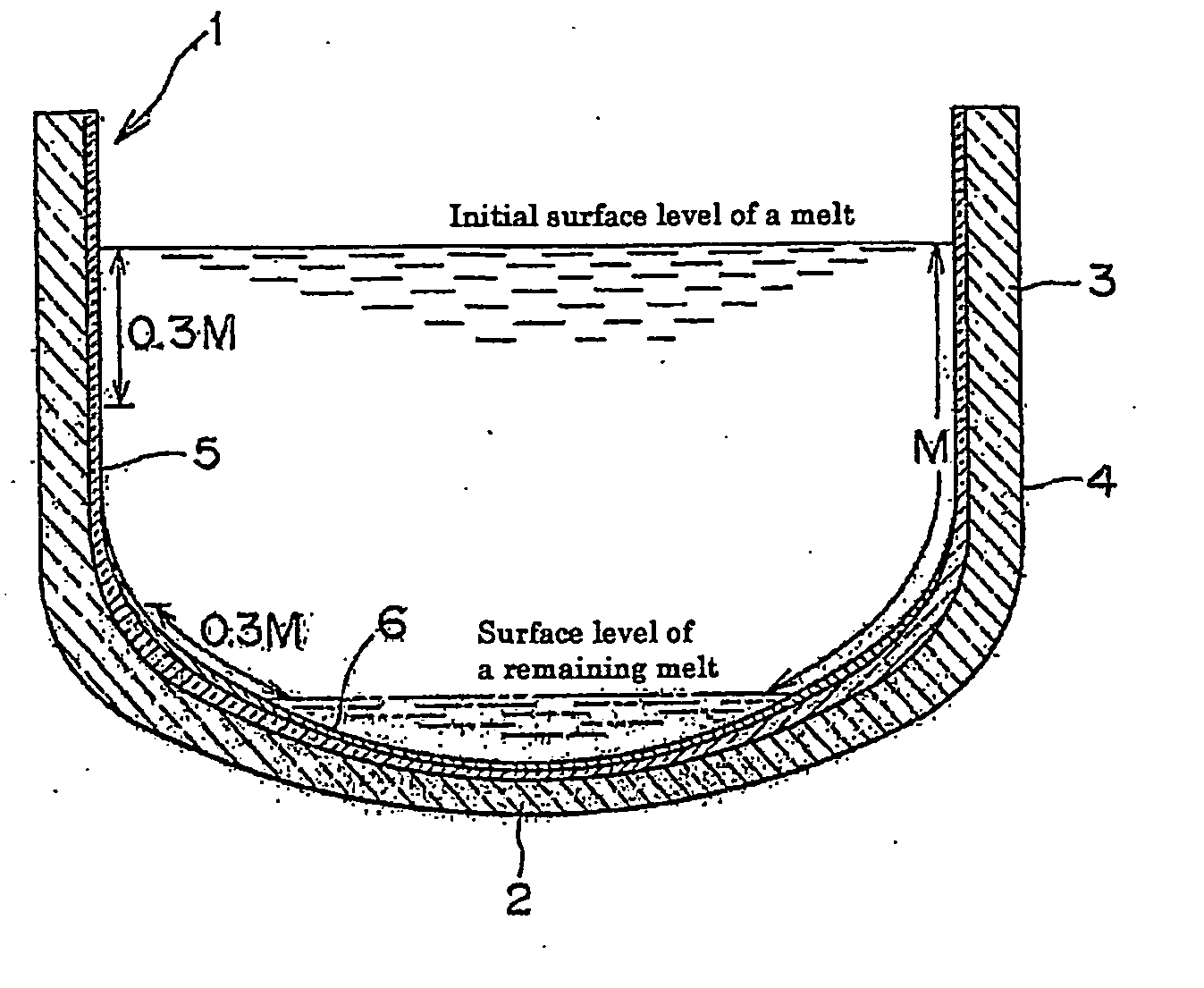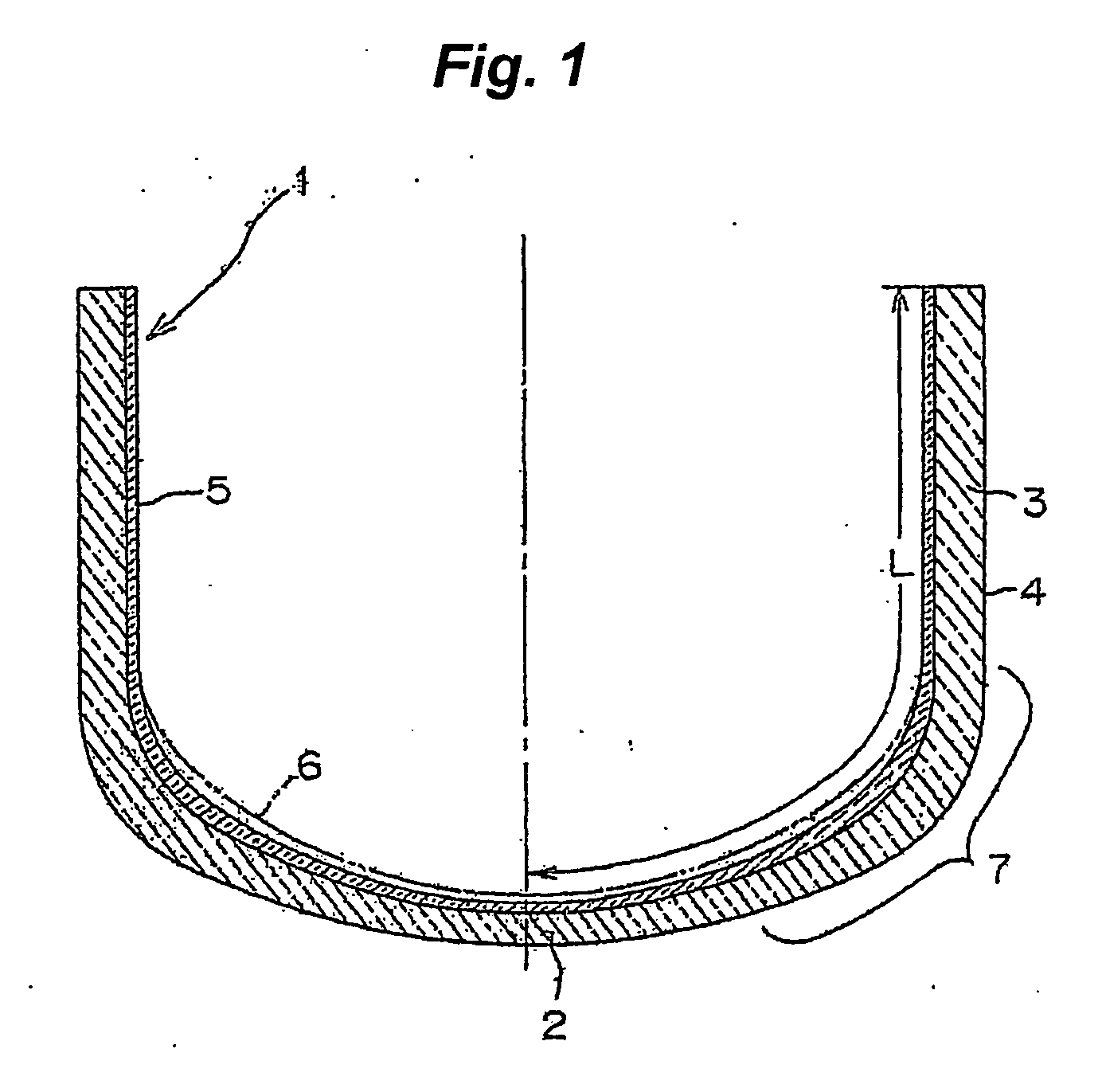Quartz glass crucible for pulling up silicon single crystal and method for manufacture thereof
a technology of silicon single crystal and glass crucible, which is applied in the direction of polycrystalline material growth, manufacturing tools, and under a protective fluid, can solve the problems of deformation or peeling of the transparent inner layer, distortion at the boundary between the two layers, and inconvenient yield, so as to suppress the occurrence of glass dissolving surface and improve the yield of pulling up a single crystal.
- Summary
- Abstract
- Description
- Claims
- Application Information
AI Technical Summary
Benefits of technology
Problems solved by technology
Method used
Image
Examples
example 1
[0024] By using an apparatus shown in FIG. 3, natural silica powder of high purity subjected to a purification treatment was fed into a rotatable mold 8, and a crucible-like molded article 9 was formed by utilizing centrifugal force. Then, an arc electrode 14 was inserted in the article, and the opening portion was covered with a plate-like lid 11. Then, the inside of the inner cavity was made a high temperature gas atmosphere by the arc electrode 14, melted and vitrified, and then cooled, whereby an opaque outer layer 4 with a thickness of 8 to 10 mm was produced. Subsequently, the inner cavity of the opaque outer layer 4 was made a high temperature atmosphere 16 by the arc electrode 14 while rotating the mold 8, and then natural silica powder was fed at 100 g / min from a silica powder feeding nozzle 15, whereby a transparent layer 5 with a thickness of 0.9 to 2 mm made of natural quartz glass was fused and integrated to the inner surface of the opaque outer layer 4. Subsequently, a...
examples 2 to 5
[0025] In Example 1, the transparent layer 5 made of natural quartz glass and the transparent layer 6 made of a synthetic quartz glass, which form the inner surface of a quartz glass crucible, were fused and integrated so as to have a thickness shown in Table 1, respectively, whereby a 24-inch quartz glass crucible was produced. The average OH group concentration in each layer of the produced quartz glass crucible was as shown in Table 1. By using this quartz glass crucible, pulling up of a silicon single crystal was carried out in the same manner as in Example 1. The results are shown in Table 1.
TABLE 1Example 2Example 3Example 4Example 5Transparent layerThickness0 to 0.55 L: 1 to 3 mm;0 to 0.1 L: 0 mm;0 to 0.55 L: 0.3 to 0.8 mm;0 to 0.55 L:made of synthetic0.55 to 0.6 L: 0.2 to 1 mm;0.1 to 0.15 L: 0 to 0.3 mm:0.55 to 0.6 L: 0 to 0.3 mm;0.3 to 0.8 mm;quartz glass0.6 to 1 L: 0.1 to 0.2 mm0.15 to 0.55 L: 0.3 to 1.2 mm;0.6 to 1 L: 0 mm0.55 to 0.6 L:0.55 to 0.6 L: 0.2 to 0.4 mm;0 to ...
example 6
[0027] By using an apparatus shown in FIG. 3, natural silica powder of high purity subjected to a purification treatment was fed into a rotatable mold 8, and a quartz glass crucible-like molded article 9 was formed by utilizing centrifugal force. Then, an arc electrode 14 was inserted in the article, and the opening portion was covered with a plate-like lid 11. Then, the inside of the inner cavity was made a high temperature gas atmosphere by the arc electrode 14, melted and vitrified, whereby an opaque quartz glass outer layer 4 was produced. Subsequently, natural silica powder was fed at 100 g / min from a silica powder feeding device 10, whereby a transparent layer 5 made of natural quartz glass was fused and integrated to the inner surface of the opaque quartz glass outer layer 4. Then, a synthetic silica powder was fed at 100 g / min from a silica powder feeding device 15, and after the use in the pulling up of a silicon single crystal, a transparent layer 6 made of a synthetic qua...
PUM
| Property | Measurement | Unit |
|---|---|---|
| Fraction | aaaaa | aaaaa |
| Fraction | aaaaa | aaaaa |
| Fraction | aaaaa | aaaaa |
Abstract
Description
Claims
Application Information
 Login to View More
Login to View More - R&D
- Intellectual Property
- Life Sciences
- Materials
- Tech Scout
- Unparalleled Data Quality
- Higher Quality Content
- 60% Fewer Hallucinations
Browse by: Latest US Patents, China's latest patents, Technical Efficacy Thesaurus, Application Domain, Technology Topic, Popular Technical Reports.
© 2025 PatSnap. All rights reserved.Legal|Privacy policy|Modern Slavery Act Transparency Statement|Sitemap|About US| Contact US: help@patsnap.com



